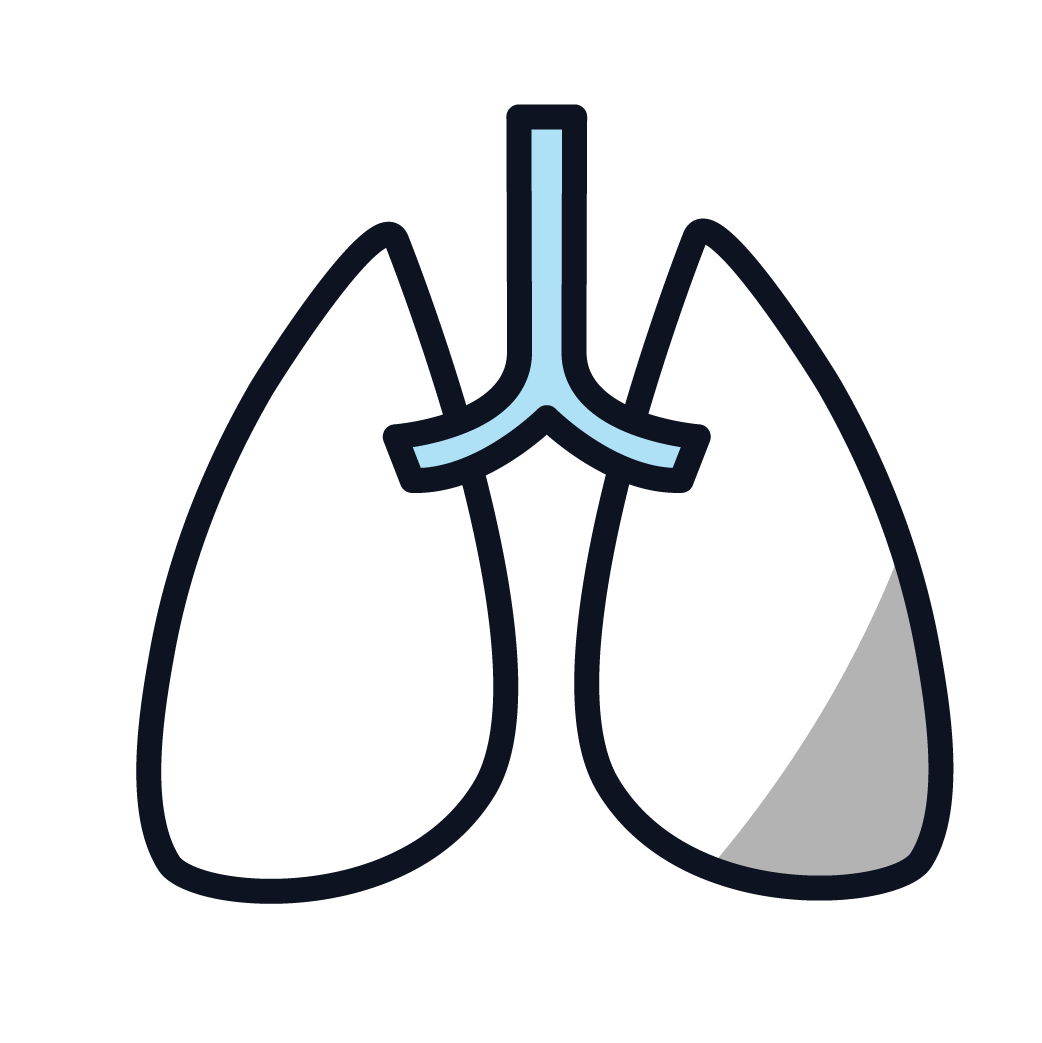Medically Reviewed by: Muaiad Kittaneh, MD, FACP, MBA | January 28th, 2020
Multiple cancers and diseases can be attributed to asbestos exposure. The most common illness caused by asbestos, however, is cancer called mesothelioma. Tumors can appear in the tissue lining of the lung (pleural mesothelioma), the lining of the abdomen (peritoneal mesothelioma), or the lining of the heart (pericardial mesothelioma). Asbestos exposure can also lead to other life-threatening illnesses like asbestosis, pleural disease, and lung cancer. Prolonged exposure has also been implicated as a potential cause of other cancers such as cancer of the larynx, ovaries, pharynx, stomach, colon, and colorectal cancer.
Asbestos is a naturally occurring mineral and human carcinogen (cancer-causing substance). It is durable, fire-resistant, and has been used in both commercial and industrial applications since the 20th century. Exposure to asbestos is hazardous to your health and causes a rare form of cancer called mesothelioma as well as other conditions. Mesothelioma may develop in the chest around the lungs (pleural mesothelioma), around the heart (pericardial mesothelioma), in the abdomen (peritoneal mesothelioma) or in the testicles (testicular mesothelioma). Several other conditions can occur from exposure as well, such as asbestosis.
There are six types of asbestos. Serpentine and amphibole are the two most common. Chrysotile, the only serpentine (twisted) form of the mineral, accounted for nearly 90 percent of commercial use across the globe. Also referred to as white asbestos, chrysotile’s defining properties consist of its malleability and long, winding fibers.
The remaining five minerals fall under the amphibole classification — actinolite, amosite (brown asbestos), anthophyllite, crocidolite (blue asbestos), and tremolite. Unlike the curly structure found in serpentine asbestos, amphiboles have short, straight, stiff fibers.
While each form of the fiber has unique properties and structures, all types are hazardous to humans and are proven to cause cancer.
Asbestos doesn’t pose much of a health risk when undisturbed. It’s only when fibers are released into the air and ingested or inhaled that they pose a health risk. That’s when microscopic fibers can latch onto the mesothelium, causing irritation and inflammation, and leading to the formation of scar tissue. Over time the scar tissue can mutate and form malignant mesothelial cells that form mesothelioma.
The adverse health effects of inhaled or ingested fibers can take anywhere from several years to decades to appear. Due to the long latency period (time between initial exposure and the development of the disease), and the slow onset of symptoms, mesothelioma is often overlooked until it reaches advanced stages.
Mesothelioma is the most common cancer caused by exposure to asbestos. However, asbestos and cancer are closely linked in other areas of the body, as well. The following malignant tumors are connected to the carcinogenic mineral.

This cancer affects the lining of the chest (pleural), abdomen (peritoneal), and, in rare cases, the heart (pericardial) or testicles (testicular). Asbestos exposure causes mesothelioma, also known as asbestos cancer.

There are several risk factors for lung cancer, such as smoking, but it’s also been linked to asbestos exposure. Pleural mesothelioma is located in the lining of the chest or lungs, and lung cancer develops within the lung itself.

This cancer affects the tissues around the larynx, otherwise known as the voice box. Like lung cancer, many factors can cause laryngeal cancer, including asbestos.

This disease also affects one specific section of the throat, specifically the tube inside the neck behind the nose that stretches to the windpipe. While the exact cause of this disease is unknown, it’s been linked to asbestos exposure.

While rare, ovarian cancer has been linked to the ingestion or inhalation of asbestos. The exact cause of the disease is unclear, but research has connected this condition to exposure in the past. Three types of cancerous cells can develop in the ovaries: epithelial tumors, stromal tumors, and germ cell tumors. This cancer affects tissues in the ovaries or female reproductive glands.

While not always connected to asbestos exposure, stomach cancer has been linked to the deadly carcinogen and forms in mucus-producing cells that line the stomach, also known as adenocarcinoma.

Colon cancer affects the large intestine (colon), which is the final section of the digestive tract. It’s also known as colorectal cancer, and it usually begins as a clump of cells called polyps that develop inside of the colon and can eventually turn into cancer.
Besides mesothelioma, the following asbestos-related conditions are more common. Non-malignant diseases can develop either after years of cumulative exposure or after just one incident.
Inhaling asbestos fibers over a long period may create scarring in the lungs. As lung function diminishes, patients, living with asbestosis experience difficulty breathing. Researchers believe smoking exacerbates this condition.
This occurs when tiny air sacs (alveoli) located in the lung deflate or become filled with alveolar fluid. Atelectasis may lead to lung collapse. This condition is often the result of other respiratory ailments, such as lung tumors, but commonly happens after surgery as well.
Chronic obstructive pulmonary disease (COPD) is a chronic inflammatory lung condition that obstructs airflow in the lungs, subsequently weakening them. Long-term exposure to irritating gases or particulate matter has been known to cause COPD, and it’s also a symptom of excessive smoking. People exposed to asbestos for an extended period are at a higher risk of developing COPD, and in some cases, are more likely to develop other conditions.
An accumulation of hyalinized (degenerated tissues and cells that have become clear, structureless and homogeneous) collagen fibers creates a condition called pleural plaques. Sometimes this will cause calcified build-ups around the lungs, making breathing difficult and painful. This condition usually affects the parietal pleura, adjacent to ribs and diaphragm, and can stimulate lung disease.
Pericardial effusion develops when fluid builds up in the pericardium, or the sac surrounding the heart. Usually, there’s already a thin layer of liquid in this space, but if the pericardium becomes injured or diseased, subsequent inflammation can lead to excess fluid.
Similar to pericardial effusion, peritoneal effusion (also known as ascites) occurs when there’s excess fluid in the abdomen. This condition is a symptom of peritoneal mesothelioma.
Pleural effusion occurs when there’s excess fluid between the pleural layers outside the lungs. The pleura are thin membranes that line the lungs, aid in lubrication, and facilitate breathing.
After exposure to infection, inflammation, trauma, tumor, radiation, or asbestos, a person is more prone to pleural thickening, or abrasions in the pleural lining. Thickening can cause moderate to severe breathing issues.
Otherwise known as pleurisy, this condition affects the pleura. There are several causes of pleurisy, including asbestos exposure. When the lining surrounding the chest cavity and lungs becomes inflamed, patients may experience a severe cough, shortness of breath, chest pain, and even fever.
Companies used asbestos in a wide variety of products and applications, even after it was classified as a carcinogen. It’s durable and fire-resistant nature made it highly desirable for insulation, flooring, piping, automobile clutches and brakes, paints, adhesives, fireproof clothing and blankets, household appliances, and even talcum powder, which is used in some makeup and baby powders. It’s still found in older homes, schools, hospitals, and commercial buildings.
Despite its many beneficial properties, asbestos is lethal when disturbed. Humans have been exposed to asbestos environmentally, occupationally, and even accidentally, often resulting in some form of cancer or other condition.
If you’re diagnosed with asbestos conditions and it’s a result of asbestos exposure on the job, you have a right to compensation.
Jennifer Verta thrives as a digital content writer at Mesothelioma Hub. She has been producing content for clients since before she graduated from the University of Colorado at Denver with a Bachelor of Arts in Communication and a Minor in English Writing. Jen’s mission is to help promote awareness of mesothelioma to as many people as possible by providing only the most up-to-date and accurate content available. When she isn’t cranking the gears at work, Jen can be found snowboarding, hiking, catching live music, or socializing with friends.

Dr. Muaiad Kittaneh, MD, FACP, MBA, is a medical oncologist and assistant professor at Loyola University of Chicago. His journey in healthcare includes Internal Medicine training at Advocate Christ Medical Center/University of Illinois of Chicago, where he excelled as Chief Resident. Dr. Kittaneh further honed his expertise at the University of Miami.
Dr. Kittaneh has conducted extensive research and assisted in many clinical trials. His notable contributions have been published in journals across the United States, which focus particularly on breast, melanoma, and gastrointestinal cancers. As an expert medical reviewer, Dr. Kittaneh plays a crucial role in shaping and evaluating Mesothelioma Hub’s content, ensuring accuracy and relevance in the field.
American Cancer Society. (2015). Asbestos and Cancer Risk. Retrieved on July 25th, 2018, from https://www.cancer.org/cancer/cancer-causes/asbestos.html
American Cancer Society. (2018). Risk Factors for Malignant Mesothelioma. Retrieved on July 25th, 2018, from https://www.cancer.org/cancer/malignant-mesothelioma/causes-risks-prevention/risk-factors.html
American Cancer Society. (2018). What Causes Malignant Mesothelioma? Retrieved on July 25th, 2018, from https://www.cancer.org/cancer/malignant-mesothelioma/causes-risks-prevention/what-causes.html
Asbestos Disease Awareness Organization. (2016). Homepage. Retrieved on July 25th, 2018, from http://www.asbestosdiseaseawareness.org/
Cleveland Clinic. (2019). Pleural Effusion Causes, Signs & Treatment. Retrieved on August 28, 2019 from https://my.clevelandclinic.org/health/diseases/17373-pleural-effusion-causes-signs–treatment
The Free Dictionary. (2019). Hyaline Degeneration. Retrieved on August 27th, 2019 from https://encyclopedia2.thefreedictionary.com/hyaline+degeneration
International Agency for Research on Cancer. (2012). IARC Monographs on the Evaluation of Carcinogenic Risks to Humans, No. 100C. Retrieved on July 25th, 2018, from https://www.ncbi.nlm.nih.gov/books/NBK304374/
Mayo Clinic. (2018). Asbestosis. Retrieved on July 25th, 2018, from https://www.mayoclinic.org/diseases-conditions/asbestosis/symptoms-causes/syc-20354637
Mayo Clinic. (2019) Atelectasis. Retrieved on August 27th, 2019 from https://www.mayoclinic.org/diseases-conditions/atelectasis/symptoms-causes/syc-20369684
Mayo Clinic. (2019) Colon Cancer. Retrieved on August 27th, 2019 from https://www.mayoclinic.org/diseases-conditions/colon-cancer/symptoms-causes/syc-20353669
Mayo Clinic. (2019) COPD. Retrieved on August 27th, 2019 from https://www.mayoclinic.org/diseases-conditions/copd/symptoms-causes/syc-20353679
Mayo Clinic. (2019) Ovarian Cancer. Retrieved on August 27th, 2019 from https://www.mayoclinic.org/diseases-conditions/ovarian-cancer/symptoms-causes/syc-20375941
Mayo Clinic. (2019) Pericardial Effusion. Retrieved on August 27th, 2019 from https://www.mayoclinic.org/diseases-conditions/pericardial-effusion/symptoms-causes/syc-20353720
Mayo Clinic. (2019) Pleurisy. Retrieved on August 27th, 2019 from https://www.mayoclinic.org/diseases-conditions/pleurisy/symptoms-causes/syc-20351863
Mayo Clinic. (2019) Stomach Cancer. Retrieved on August 27th, 2019 from https://www.mayoclinic.org/diseases-conditions/stomach-cancer/symptoms-causes/syc-20352438
Science Direct. (2010). Amphibole. Retrieved on July 25th, 2018, from https://www.sciencedirect.com/topics/pharmacology-toxicology-and-pharmaceutical-science/amphibole
Science Direct. (2009). Pleura Plaque. August 27th, 2019 from https://www.sciencedirect.com/topics/medicine-and-dentistry/pleura-plaque#targetText=Hyaline%20Pleural%20Plaque&targetText=They%20occur%20most%20often%20on,not%20found%20in%20the%20lesions.
World Health Organization. (2018). Asbestos: Elimination of Asbestos-Related Diseases. Retrieved on July 25th, 2018, from http://www.who.int/news-room/fact-sheets/detail/asbestos-elimination-of-asbestos-related-diseases